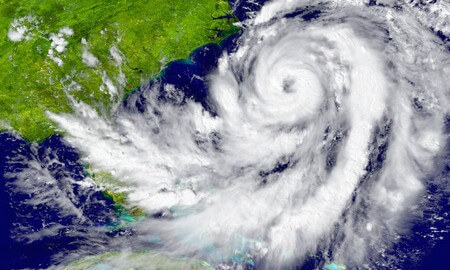
Getting Your Property Ready for a Hurricane
There are many measures you can take that can help your home fare better in various hurricane conditions. But, as we learned from Hurricane Irma, it is important to take timely actions for hurricane preparedness in and around your home. Roofs, doors, windows, and garage doors, and multiple other points around your home are the most vulnerable to breaches by hurricane winds, water surges, and flooding. And, there are likely to be various conditions existing in and around your home that increase your home’s risk of hurricane damage. Here are some tips for getting your home ready for a hurricane.
- Secure your windows.
Experts suggest that merely taping across windows is a futile effort that may give homeowners a false sense of security during a hurricane. The National Hurricane Center (NHC) advises providing more realistic protection for your home, its contents, and especially for occupants, by securing your all windows with properly hinged storm shutters.
Purchase commercial quality shutters at your local home improvement store, or have a professional contractor install storm quality shutters on your home. Ideally, this should be completed before a hurricane is moving toward your area.
The alternative emergency measure of recessing plywood sheets into window cavities is recommended to help protect against an approaching hurricane. This approach is known to work better than just nailing boards across the windows. See The National Hurricane Center website for detailed instructions for installing temporary recessed plywood shutters.
Although shatter-resistant glass or window films may be helpful, according to the NHC, these are not comparable to shutters in the degrees of protection they provide. Hurricane experts agree with typical building codes, which do not accept window film as adequate window treatment for protection of homes against hurricane.
- Secure your doors.
Adding commercial storm doors is recommended, especially over any door consisting mostly of large panels of glass, such as French doors or sliding glass patio doors, per the NHC. For all home doors, experts suggest additionally installing barrel bolt latches with bolts extending into the door header and into the floor.
- Secure your garage doors.
Garage doors that are not hurricane rated should be shuttered with storm quality shutters. Or, as an emergency preparation, cover the expansive door with recessed plywood and add exterior bracing to better secure the door. Obtain advice from your local home improvement store representative about commercial retrofit hurricane protection systems for your garage door.
Explore alternatives such as commercial or home-made braces that can help protect the door against buckling in. However, neither braces nor retrofit storm kits can protect against impact by projectiles. Consider installing metal or wooden girds, and other precautions you can take to make your garage door more secure during a hurricane.
- Protect against water entry in small openings.
Install sealed plates or utility inlet shutters at all necessary points throughout your home and around its exterior. This includes any insufficiently sealed areas around vents or HVAC ductwork, plumbing pipe and electrical conduit entry points into your home. Secure roof ridge, gable, and soffit vents.
- Clean up all potential projectiles from your yard.
Trim tree branches, and remove dead or damaged trees, to prevent them from uprooting and becoming projectiles in hurricane winds. Remove all lawn furniture, dog houses, yard decor, potted plants, trash cans, recycling bins, and toys, if possible. Disassemble barbecue and fire pits, swing sets, and trampolines and temporarily store these in the garage.
- Fortify your roof.
Repair any roof defects that render your roof more susceptible and further fortify the roof, if possible. Consider hurricane straps, if appropriate for your roof. Use duct tape to seal gaps, where appropriate. Especially if your roof is aged, consult with your local roofing expert about roof replacement with one of the several roof types recommended as most effective in protecting homes against hurricane damage, and consider replacing your roof with one of these types.
- Move your car away from your driveway.
Protect your car and your home, by preventing your car from potentially becoming a projectile during the strongest hurricanes. If possible, relocate your car into a more secure location, in your garage, a neighbor’s spare garage space, or even in a parking garage or other area away from the vicinity of your home. (This also may help ensure your car is not destroyed by flood water, protecting your means of transportation after the hurricane.)
- Protect your valuables.
Place important documents, including deeds, titles, and other proof of ownership documents, passports, birth certificates, medical insurance certificates and policy documents, and all others in a waterproof container. And, move the container to a higher and safer location in your home.
Make digital and paper copies of all documents as part of your advance preparations, and place those in a waterproof transportable covering to keep in your evacuation bag. And, make a list of valuable items such as family heirlooms and electronics that need to be temporarily waterproofed and moved to higher locations in your home during emergency preparations for impending flood.
- Promptly undertake capital improvements as well as maintenance basics .
Invest in home improvements such as installing high-wind-resistant windows, doors, and garage doors, with storm-grade shutters over all of these, along with an ideal roof type, if possible, for optimum hurricane preparedness.
And, performing essential maintenance, like using high-grade caulking around all door seals, window frames, vents, and utility cable and pipe entry points into your home, may help protect against water entry during flooding.
Above all, work in advance to protect your entire home from as much damage as possible, in order to ensure that you experience the least property destruction and the least amount of inconvenience from being forced out of your home during lengthy repairs.
- Review your homeowner insurance policy.
Review your homeowner policy to understand which items are covered and which are not.
After you are confident that you are clear on which of your belongings that you can and cannot reasonably expect to insure, prepare accordingly. Move these items to higher levels in your house or to a safe temporary storage elsewhere, if necessary, or take other actions in advance to protect uninsured or underinsured valuables.
We are here to help. We want to make sure you understand and know your policy coverage. Please call with questions to 800) 443-7007.

 Previous Post
Previous Post Next Post
Next Post